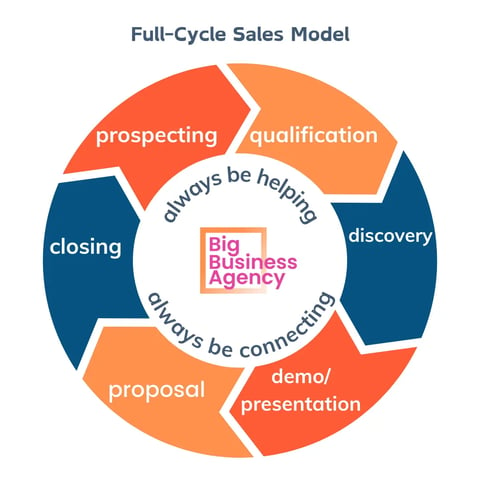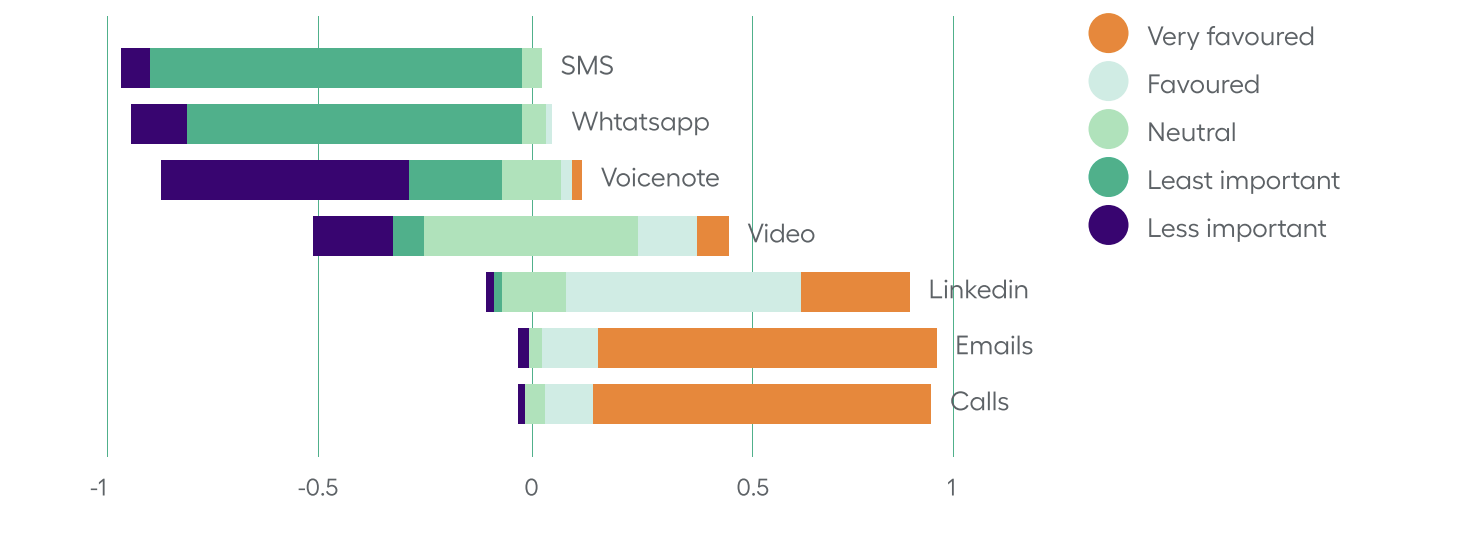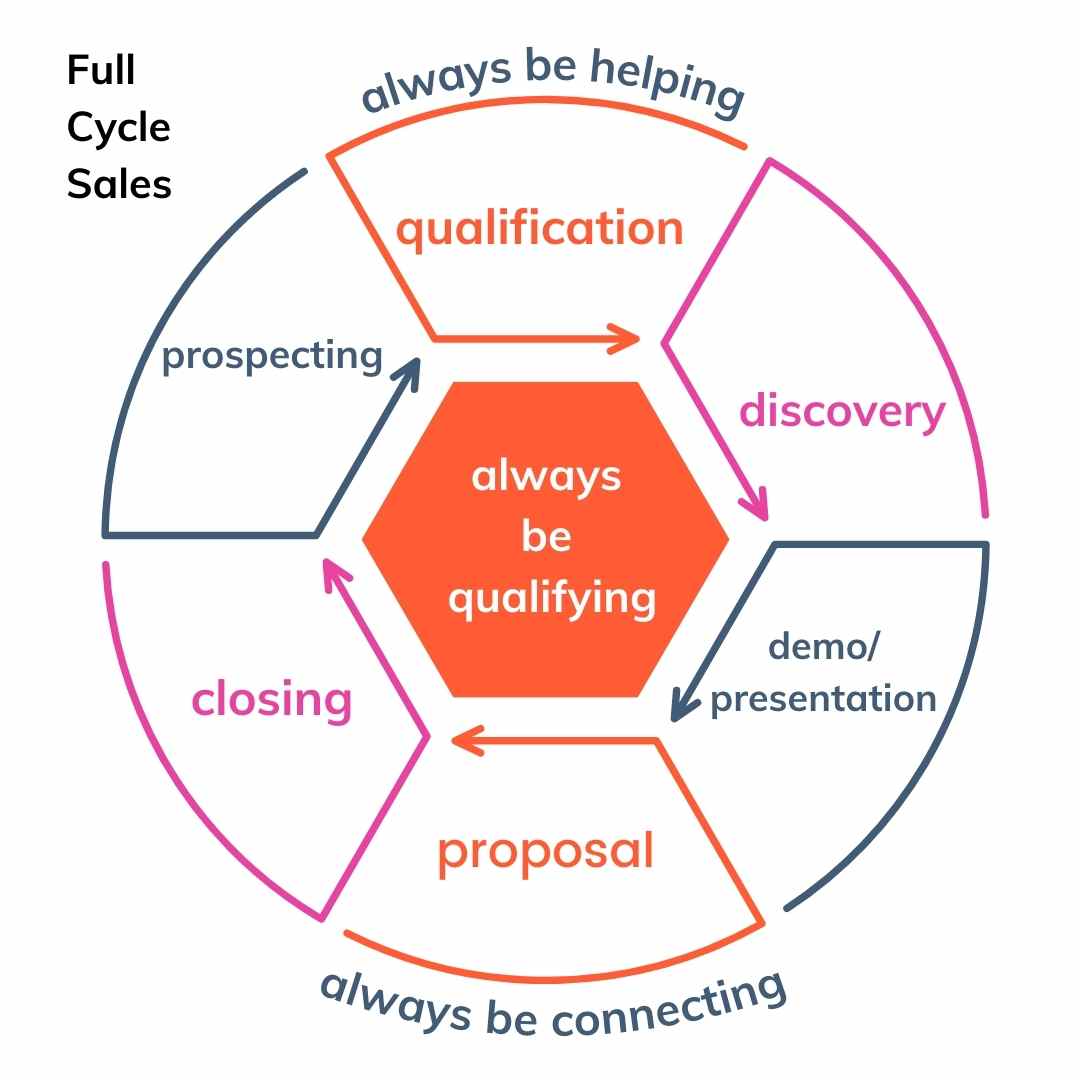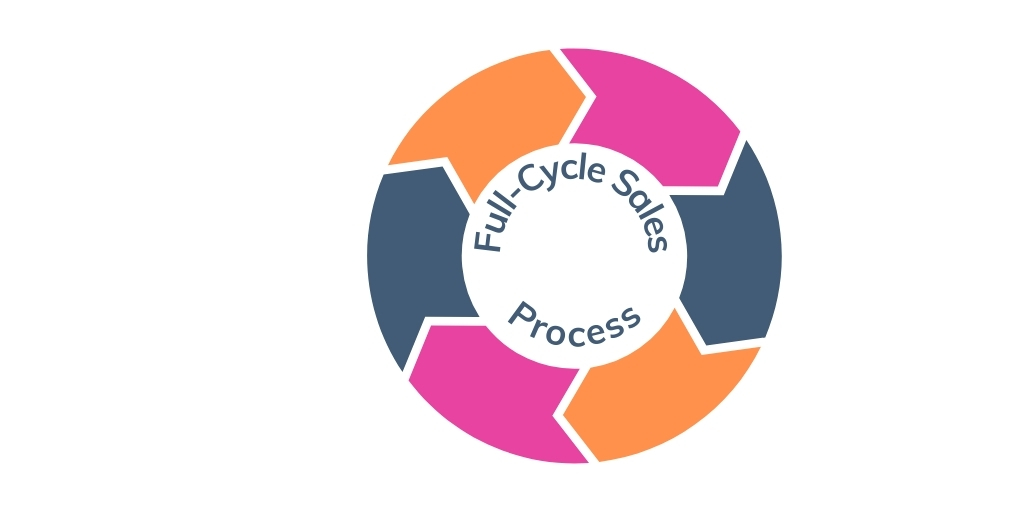What does full cycle sales mean in B2B sales?
Curious about Full Cycle Sales? Full-cycle sales is a sales model that requires the salesperson to prospect all of their leads and manage the deal...
Feeling a bit frustrated or simply confused about the SDR/AE Model?
Wondering why in the world you would need a BDR and an SDR? Or maybe you're wondering how these roles fit into full-cycle sales?
Well, don't worry, we've got the lowdown to help you get your head around it all!
Let's dive in and take a closer look at each role.
tune in now
Lets discuss, one at a time...
A Sales Development Rep is like the ultimate inside sales rep, selling products or services from the comfort of their desk instead of going out into the big bad world. Using multi-channel outreach to prospect, and pursue leads SDRs are sometimes known as inside sales or digital sales reps and typically focus on inbound leads.
One of the greatest perks of being an SDR is the opportunity to sharpen your skills in specific areas of the sales process. SDRs can become masters in prospecting and making it their secret weapon. By dividing tasks, SDRs focus on early funnel stages with the goal of specialising to gain greater success.
Before reaching out to potential leads, SDRs invest time in research to understand their businesses and challenges. If they believe the prospect is a good fit, they'll hand it off to a more experienced salesperson, such as an account rep or executive. It's like passing the baton to the pros.
In larger companies sometimes SDRs collaborate with BDRs to create a prospecting database they can share. So now you might be thinking.....
A Business Development Representative (BDR) is responsible for generating new business opportunities by qualifying leads and prospecting through new and existing business accounts to engage with potential buyers.
Sales Managers understand the importance of outbound sales and therefore entrust business development representatives (BDRs) with the crucial task of qualifying leads and initiating contact with potential clients.
BDRs have a knack for conducting thorough research and actively seeking out new leads and potential customers in untapped areas. They dedicate their efforts to outbound lead generation and qualification methods, including spending time on MQLs. Once the qualification process is complete, BDRs convert cold leads into warm prospects and then pass on the lead to an AE.
An account executive (AE) is a salesperson with primary day-to-day responsibility for an ongoing business relationship with a customer and to close deals. AEs have a detailed understanding of a customer company's objectives, products and solutions with the main objective of retaining and growing customer relationships.
Typically Account Executives need to have the following skills and attributes;
In the SDR/BDR/AE Model, sales teams are strategically divided into two distinct groups to optimise their effectiveness. Usually SDRs & AEs, sometimes BDRs and AEs and although not common, sometimes you will get a mix of SDR/BDRs and AEs.
 Between them, these groups cover all aspects of the sales cycle that looks
Between them, these groups cover all aspects of the sales cycle that looks  something like this;
something like this;
1. Prospecting
2. Qualifying
3. Discovery
4. Demo/Product or service presentation
5. Overcoming objections
6. Proposal
7. Closing the sale
Businesses that have SDR and BDR teams will usually divide their sales cycle somewhere around stages 3, 4, or maybe 5. The exact split depends on the sales manager's judgment and what works best for their business.
BDRs hand over their prospects to either SDRs or account executives (AEs). This split approach means that different salespeople take on different responsibilities which can lead to communication issues and a lack of continuity for the buyer as they interact with multiple salespeople.
The specific responsibilities for these positions are determined by each company. It is not uncommon for companies to use the terms "BDR" and "SDR" interchangeably, and they may refer to the same role with different names.
 There are various titles for this function, such as Lead Generation (Lead Gen), Business Development (Biz Dev) Appointment Setting, Lead Qualification, and Junior Sales Rep.
There are various titles for this function, such as Lead Generation (Lead Gen), Business Development (Biz Dev) Appointment Setting, Lead Qualification, and Junior Sales Rep.
In the vast world of sales organisations, you might come across some larger companies that have multiple sales development functions. It's like having a secret code to decipher!
One could be responsible for qualifying inbound leads, while the other tackles outbound leads. And to add to the complexity, one might hand off to an account executive in the inside sales team or maybe in the digital sales team, while the other collaborates with the field sales team.
It's like a sales puzzle waiting to be solved! So it's always a really good idea to ask clarifying questions to truly understand the job role and the responsibilities of a BDR or SDR member of the sales team!
If you're looking to strengthen your sales operations beyond just tools and integrations, our Sales Consulting Services can help you design a strategy that drives real, measurable growth.
Curious how your sales process stacks up? Book a call with our consultants and get actionable insights - fast.
In response to high costs and the dissatisfaction with the SDR/AE model and the negative impact it has on customer experience, many companies are embracing a new trend known as full-cycle sales. This approach involves the adoption of full-cycle sales reps, who take on the responsibility of prospecting leads, closing deals, and managing accounts.
This shift towards full cycle sales aims to provide a more seamless and efficient sales process, ultimately improving customer satisfaction. Visit our full cycle sales page for information on our related sales consulting services.
 In the old days, sales meant you hunted it, killed it, ate it, or maybe you farmed it!
In the old days, sales meant you hunted it, killed it, ate it, or maybe you farmed it!
Full cycle sales is a return to this thinking - a method for providing B2B (and B2C) sales that puts individual sales reps in control of the whole sales process.
Although models can differ, in a typical sales cycle, there are various stages to consider:
1. Self Sourced Prospecting
2. Qualifying
3. Discovery
4. Demo/Product or Service Presentation
5. Overcoming objections
6. Proposal
7. Negotiating and Closing the sale
Let's face it, stages like qualification and discovery are never really over until the deal is closed. Like your reliable companions throughout the sales cycle... always there to guide you until you reach the closing stage. But hang on, there's no finish line at stage seven!
Sales keep on going, round and round, from stage one, prospecting, all the way to closing the deal. In a full-cycle sales model, a single sales person takes charge of the entire journey, handling initial prospects and seeing it through to the final sale and sometimes post-sale account management before doing it all over again!
Full cycle sales means a sales person handles the entire sales process. If you have questions about how could work for your business, send us your question and we will answer you the same day.
Full-cycle sales is a beneficial approach for all types of businesses, but it particularly suits Startups and Mid-market companies as it provides the best ROI on Sales and Marketing investments.
 That being said, larger-sized businesses can also effectively implement a full-cycle sales model. In larger organisations, the implementation of a full-cycle sales model allows for a more streamlined and efficient sales process.
That being said, larger-sized businesses can also effectively implement a full-cycle sales model. In larger organisations, the implementation of a full-cycle sales model allows for a more streamlined and efficient sales process.
By assigning a single sales representative to handle the entire sales journey, from prospecting to closing deals and managing accounts, there is a higher level of continuity and accountability.
This eliminates any potential communication issues or lack of continuity that may arise when multiple salespeople are involved in different stages of the sales cycle.
Furthermore, adopting a full-cycle sales model in larger companies can help address challenges that may arise with split sales models.
For instance, when BDRs pass on leads and the receiving AE team they hand over fails to close them, BDRs may feel compelled to close deals themselves. This obviously can cause issues for sales managers who have disgruntled sales executives as well as dissatisfied BDRs on their teams.
Similarly, when BDRs and SDRs fail to hand over leads to the AEs at the appropriate time, it can create friction and frustration among the sales team. This occurs too often and unfortunately, such situations can lead to resentment among SDR and AE teams, especially when disputes arise over bonuses and commissions.
By transitioning to a full-cycle sales approach, these challenges can be alleviated, leading to a more motivated and productive sales team.
By focusing on the customer's needs and making the sales process as seamless as possible, sales representatives can generate better-qualified leads and increase customer satisfaction.
Moreover, when sales executives are involved in all stages of the sales cycle, they are more likely to accurately assess the potential of each lead and avoid prematurely disqualifying opportunities.
The Full Cycle Sales Model works for opportunities of all sizes from deals under 10k to multi-million dollar deals, full cycle sales can easily adapt to work well for any size deal.
By streamlining the sales process, ensuring continuity, and maintaining a customer-centric approach, businesses of all sizes can optimise their sales effectiveness and drive growth. This can be extended further by taking advantage of sales tools like Mobileforce CPQ, and HubSpot Sales Hub, that leverage automation and AI.
Full-cycle sales is a favoured approach by many sales managers as it offers streamlined processes and aligns with operational needs, especially for geographically dispersed or large teams.
On the other hand, some business leaders impose full-sales cycles on their senior sales executives to create a fair playing field and identify top performers. While transitioning from a split model may not be suitable for every sales team, it is important to carefully weigh the potential benefits against any short-term disruptions that may arise.
Implementing customer-centric or customer-first strategies can greatly benefit your sales team by generating highly qualified leads from engaged customers. However, it's important to acknowledge that selling to existing customers does have its challenges. Sales transactions typically occur when the customer is ready to make a purchase, which is often determined by their own timeline rather than the salesperson's efforts. This can be frustrating for salespeople to accept, and being too pushy in these situations can potentially harm the relationship with your existing customers.
Instead, it is more effective to focus on understanding your customer's wants and needs and making it as easy as possible for them to convert. By utilising a salesperson as a single point of contact for future sales, inquiries, and order follow-ups, you can provide a seamless and personalised experience for your customers.
This approach not only fosters stronger customer relationships but also increases the likelihood of repeat business and customer loyalty.
Companies are constantly seeking ways to achieve more with less and realise cost savings. Transitioning to a full-cycle sales model can help achieve this. With full-cycle sales, a single sales representative takes charge of the entire journey, from prospecting leads to closing deals and managing accounts. This approach provides a more seamless and efficient sales process, ultimately improving customer satisfaction.
By having a single sales representative responsible for the entire sales cycle, companies can streamline their operations and reduce the need for multiple salespeople involved in different stages of the process. This not only saves on resources and costs but also ensures better continuity and accountability throughout the sales journey.
If your sales process involves both BDRs and account executives or SDRs, and AEs it can certainly be effective. Some clients may prefer to maintain their relationships with their account executive, especially if they are satisfied with the service they are receiving.
However, most customers prefer to have a single point of contact throughout the entire sales process. This is often the case for customers returning after a period of not placing orders or for customers who require personalised service for each order.
If you are hearing this feedback from any or all of your customers, transitioning to a full-cycle sales approach would be a logical step. This approach can be particularly beneficial in B2B Sales scenarios where client entertainment, product education, or technical sales are important considerations.
When you have inadequately trained SDRs who lack a deep understanding of your value proposition and overall sales process, it can lead to subpar results in lead qualification.
While it's natural for SDRs to disqualify some leads during the qualification process. For example, the prospect may not be a good fit or may not be ready to make a purchasing decision.
In contrast, when sales executives are responsible for both prospecting and lead qualification, they are more likely to abandon leads only when it becomes evident that there is no potential for progress.
When a sales rep is solely focused on lead qualification and has not been involved in earlier stages of the sales process, it becomes easier to disqualify leads without fully exploring their potential. This can result in missed sales opportunities that could have led to successful closures.
While a split team sales model doesn't necessarily mean that you are discarding good leads, there is always the potential for it to happen. However, in a full-cycle sales model, the likelihood of losing valuable leads is significantly reduced.
In some sales teams, it’ll be your sales executives - not your customers who tell you they'd prefer to work in a full-cycle sales environment. For sales executives, it means enjoying a more varied role, taking charge of all the stages in the cycle, not just one or two. Also, full-cycle sales can lead to higher revenue due to fewer disqualifications, thereby boosting the earning potential of sales reps.
Full-cycle sales models also help make the ownership of sales more clear-cut. By having one person prospect, nurture, qualify, and close their sales, there's less room for others to claim commissions or ownership of sales in which they've only had a minor role. As a result, this can lead to a happier workplace and better staff retention.
Learn about Full Cycle Sales Enablement
As well as the attributes mentioned above and having a solid sales strategy plan, top full cycle salespeople typically have mastered these sales skills/attributes;
Lead Generation with a focus on Customer Segmentation
Multi-threading and Multi-channel outreach
Clarifying Questions using Qualification Frameworks
Customer Objections
Well defined Cross-Sell and Upsell pathways
Presentation and Negotiation Skills
For more information on this topic read Beginners Guide to B2B Sales blog article
Positive Outlook: They have a strong ability to cope with ambiguity and are able to cope with high levels of stress.
Proactive Mindset: They are proactive and always on the lookout for new leads and ways to enhance the sales pipeline.
Resilience: Know that setbacks and rejections are common in the sales game, but top performers quickly bounce back, viewing challenges as opportunities for growth rather than obstacles.
Strong Communication Skills: Effective communication, both written and verbal, is crucial for building rapport with potential clients and navigating complex sales processes.
Competitive and Goal Orientated: They thrive on setting and achieving ambitious goals, constantly seeking ways to surpass targets and play a key role in driving the overall success of the sales team.
Time Management: Effectively managing multiple tasks and priorities is a key skill. They excel at prioritising activities to optimise productivity.
Adaptability: Industries, market conditions and client needs can shift swiftly. Top-performing SDRs/BDRs confidently adjust their strategies to remain ahead of the curve.
Empathy: Empathising with the customer's viewpoint and forging authentic connections aids in developing long-lasting relationships, ultimately resulting in more successful sales outcomes.
Continuous Learning: Seeks access to sales training and best practices
Visit our blog for more information on Full Cycle Sales experience.
Finding and retaining talent with the full range of skills needed to drive deals from prospecting to close is harder than ever.
Thats even more amplified when it comes to large complex Enterprise deals.
Designed to bridge the growing skills gap in full-cycle sales, Big Deal GPT empowers teams to perform at their best - whether they’re qualifying leads, overcoming objections, crafting compelling proposals, or negotiating complex deals.
With real-time insights, scalable support, and proven sales playbooks, Big Deal GPT is your AI co-seller, strategist and closer!
Sales excellence is no longer limited to experience - now it’s accessible on demand!
Discover Big Deal GPT - private and secure chats!
1:1 Sales Coaching, Strategy and Tactics to win Big Deals.jpg?width=380&height=380&name=big-deal-gpt%20(1).jpg)
You can help to reduce skill gaps by providing structured onboarding with the right AI software.
HubSpot Sales Hub has AI built in and when paired with Breeze Intelligence and Big Deal GPT qualification, data enrichment and by providing context-specific insights into prospects.
AI will not replace your human sales representatives; rather, it will enhance their efficiency by streamlining routine tasks, particularly in data enrichment and management, which can otherwise be burdensome.
By leveraging AI, your employees can avoid burnout, thereby boosting productivity and job satisfaction.
This enables your team to concentrate on high-value, strategic activities such as developing customer relationships and crafting effective strategies.
A full-cycle sales model will work best when automate correctly. Luckily, BBA knows how to get this right so you have a growth machine that transforms your business! Our comprehensive approach covers everything from prospecting to closing and after-sales support!
The tools we have access to now are one of the top reasons full-cycle sales is more effective than in the past. With a customer relationship management (CRM) system like HubSpot, you can effortlessly keep track of all your deals, right from the very beginning of the sales cycle to closing the deal and even generating new referrals from your existing clients.
One of the major perks of using HubSpot in a full-cycle sales setup is that you get to centralise all your precious prospect and customer data in one convenient location.
No more searching through multiple platforms or spreadsheets - no need for swivel chair style integration, everything you need is right at your fingertips.
With little internal overhead to maintain and run HubSpot, Opex savings of up to 50% are standard when compared to Salesforce.
Sales professionals confidently adopt HubSpot Sales Hub due to its user-friendly interface and dedicated prospecting workspace. Whether its cold calls, emails, or LinkedIn outreach, every interaction is seamlessly captured within HubSpot, streamlining follow-up processes and enhancing efficiency.
HubSpot Sales Hub allows managers to easily understand who's dealing with which clients  and, crucially, which sales rep is in charge of which contact. In a full-cycle sales model, you'll want all inbound calls and emails from a contact to go to the assigned rep.
and, crucially, which sales rep is in charge of which contact. In a full-cycle sales model, you'll want all inbound calls and emails from a contact to go to the assigned rep.
Equally, a Smart CRM that filters email correspondence and inbound phone calls seamlessly will help streamline your internal processes.
Not only does it save time among your staff, but it should also improve the customer's experience by finding their point of contact effortlessly.
HubSpot Sales Hub also provides you with sales analytics. By tracking your sales reps' performance and where they are in the sales cycle, you can better predict how to manage your financial and human resources down the line.
Likewise, if too many sales reps are at the prospecting and nurturing stages, HubSpot will be able to alert you, allowing you to make informed management decisions.
Sales Hub integrates with email, SMS, Whatsapp, calls, Video, Zoom, Teams, LinkedIn and more.
Sales Hub features an activity feed that displays target contact's activities, including email tracking, website visits, task status and a variety of other essential tools to enhance salespeople's productivity all within a single platform.
Research shows there is a "right number" of tools when it comes to sales outreach. In a HubSpot Survey of UK & Ireland sales managers from a cross section of the market, approximately 50% of the teams that responded use between three and five tools.
Having all your sales tools available in one place means better productivity, simplified operations and greater sales success.

If you're interested in finding out how our award winning B2B Sales Agency can help with boosting your sales, check out our sales consultancy page and also our sales strategy and sales process consulting services pages or get in touch for an obligation-free chat!
let's talk!
The SDR/AE model divides the sales process among different roles, with SDRs (Sales Development Representatives) or BDRs (Business Development Representatives) focusing on prospecting and qualifying leads, and AEs (Account Executives) handling the closing process.
This segmentation allows for specialisation but can create communication gaps and a disjointed customer experience.
In contrast, full-cycle sales consolidates all sales stages—prospecting, qualifying, closing, and account management—under a single salesperson.
This model enhances continuity, accountability, and customer relationships while streamlining operations and reducing internal handoffs.
The full-cycle sales model is particularly well-suited for startups, mid-market companies, and businesses that prioritise customer relationships.
If your business deals with complex sales cycles, high-value deals, or relationship-driven sales, full-cycle sales can improve efficiency and customer experience.
However, larger organisations with high-volume, transactional sales may benefit more from the SDR/AE model to maximise lead generation and specialisation.
While the SDR/AE model is effective for scaling outbound and inbound sales efforts, it can introduce challenges such as:
Misalignment between teams – SDRs/BDRs may struggle to pass high-quality leads to AEs, leading to inefficiencies.HubSpot provides a centralised Smart CRM and Sales Software (Sales Hub) that enable full-cycle sales reps to manage the entire sales journey efficiently.
Key benefits include:
Automated lead tracking – Helps reps stay on top of their pipeline from prospecting to closing.
For more successful LinkedIn Campaigns, why not consider Expandi to safely automate your connection requests?
RELATED ARTICLES
What does full cycle sales mean?
McKinsey's 7S Model to Implement Full Cycle Sales
Why is the full cycle sales model better for customers?
Sales Playbook: Winning Big Deals
Helpful Links
Align your sales process with the buyer's journey
Using POV to win large Enterprise Deals
How to write great sales emails

Curious about Full Cycle Sales? Full-cycle sales is a sales model that requires the salesperson to prospect all of their leads and manage the deal...
.jpg)
What is the future of the SDR role?

1 min read
The traditional sales model is broken - and expensive. With up to 40% higher costs and longer deal cycles, many sales leaders are ditching the...